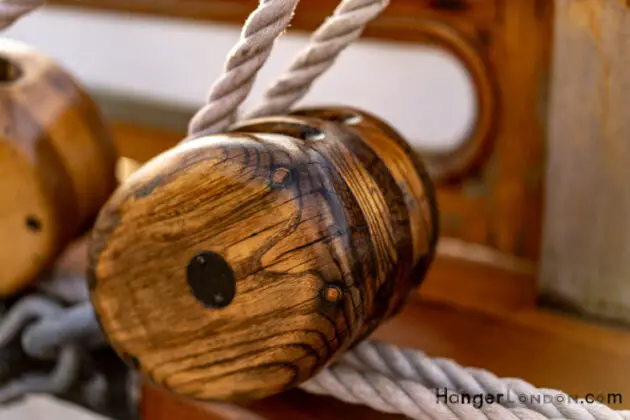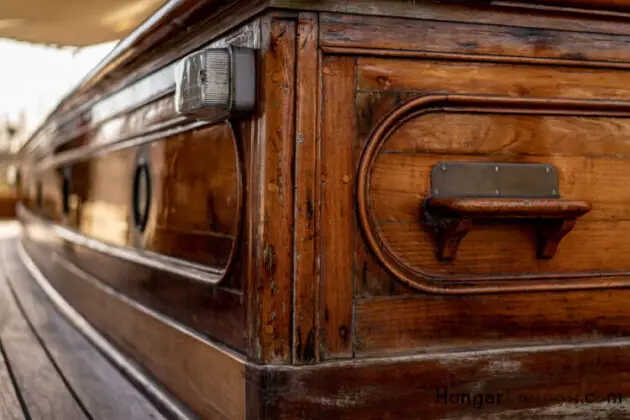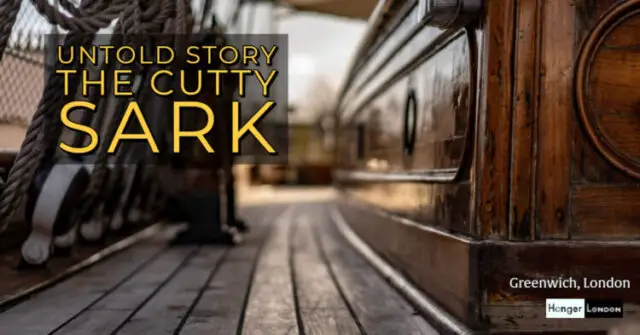In the mid-19th century, tea was a valuable commodity that was in high demand in Britain. To meet this demand, a new type of sailing ship was created: the tea clipper. These ships were designed to be fast and nimble, capable of making the long journey from China to Britain in the shortest possible time. Of all the tea clippers built, the Cutty Sark is perhaps the most famous, and more importantly, still survives today.
Built in 1869 in Scotland, the Cutty Sark was designed by Hercules Linton and constructed by the shipbuilder Scott & Linton. The ship was named after a character in the Scottish poem “Tam o’ Shanter” by Robert Burns, and its figurehead depicted the character wearing a short chemise, or “cutty sark.”
The Cutty Sark was 212 feet long and weighed 963 tons. It was constructed using the latest shipbuilding techniques of the time, including an iron frame and a composite deck made from teak and greenheart. The ship was also equipped with a large amount of canvas sail, giving it the ability to reach high speeds.
In 1870, the Cutty Sark made its maiden voyage, traveling from London to Shanghai to pick up a cargo of tea. The ship made the journey in just 107 days, setting a record for the fastest time by a sailing ship. Over the next few years, the Cutty Sark continued to make regular trips between China and Britain, carrying tea and other cargo.
The Cutty Sark continued to sail for many years, but by the early 20th century, steam-powered ships had begun to replace sailing ships. In 1922, the Cutty Sark retired from service and became a training ship for the British Merchant Navy. In 1954, the ship was acquired by the Cutty Sark Preservation Society and moved to Greenwich, London, where it was restored and turned into a museum.
Today, the Cutty Sark is one of the most popular tourist attractions in London, attracting visitors from all over the world. The ship is a testament to the ingenuity and skill of the shipbuilders of the 19th century and the brave men who sailed these magnificent vessels across the seas.
“Where there's a Willis away”
Company Motto attached to the rear of the Cutty Sark Tweet
1869
Dumbarton
£50 million pound Renovation
Cutty Sark Conservation

The project to renovate the Cutty Sark lasted 5 years and was the first complete overhaul and renovation of the ship since the ship was dry docked in Greenwich in 1954
"Goodbye, my Lads!"
John Willis Tweet
John ‘Jock’ Willis (1791-1862) founded John Willis & Sons of London ship-owning company married Janet Dunbar, and had 9 children. The eldest son also called John Willis, also known as ‘White Hat Willis’. It was during John Willis junior time the firm owned and ran tea clipper ships like the Cutty Sark, the Tweed, and the Lammermuir.
Cutty Sark Top pick purchases on the Amazon Store....
How John Willis put the Cutty Sark’s ship builder, out of business
Dunbarton 1869 by Scott & Linton Built on the Leven and River Clyde Jock Willis Shipping Line. John Willis hired Hercules Linton to build the ship and believed one of his other ships the tweed had a design structure that gave it its speed. Oliver Lang had designed that ship called Punjab and was a frigate ship. He had other clipper ships built with Iron based on designs of the Halloween and Blackadder. That he also had an interest in because of their performance. Both Willis and Linton realised that the shape of the hull was the secret to speed and they compromised in what they thought would work. They streamlined it, broader stern gave it better buoyancy. It had a squarer stern and was less fat and barrel shape.
The contract said it was to be built in 6 months there were fines if this was late £5 per day. The builders would get their money in stages. Captain George Moodie supervised the construction for Willis. He would be the Captain of the Cutty Sark on completion. Delays it needed strengthening. Scott and Linton went bankrupt building the ship.

Denny took over and completed 22 Nov 1869.
They based Cutty Sark on the Tweed which originally was a paddle steamer. Lengthened, removal of the engines, therefore turning into a sailing ship, called, Punjaub. The West India company had built it. It had made record trips and paid off. Willis suggested Hercules Linton look at the Tweed ship, before designing Cutty Sark. It’s shape unlike any other. Sailing ships that built for speed had to make sure the rough seas would not literally wash over the top and take with it the helmsmen or watch officers wheel and compass. The Ship had 2 very distinctive carved figureheads.
When did it first sail?
1869 22nd November. They towed the ship to Greenock on the Clyde, Scotland.
Towards the last week of Dec 1869 to have its rigging installed.
They moored it at the Robert Steele shipyard near there at Cartsdyke before sailing to London.
1st Voyage 16th Feb 1870
From London to Shanghai China.
2nd Voyage 1871
South China Sea Bangkok rice was delivered to Hong Kong. Before fetching Tea.
£3 per 50 Cubic Feet of Tea
Tea Cargo
The Victorians loved tea and the Cutty Sark was one of the best of getting the valuable cargo back to Britain quickly. The first to land yielded the highest profits.
1 shipment carried £270,000 Chinese Tea which in today’s money is around £18 Million. Ships competed to be the first back to England with the new Seasons import of tea. Thousands of pounds would be at stake depending on who bought the first batch in.
The Tea race advertised in papers and regarded as a sporting event. The Tea Races had lots of public interest speculation as to who would be the first back, the ships having a well-known status about them.
In the first few years, 5.5 thousand tons of tea was delivered some 144 million pounds in today’s money.
The Time of year changed the price too. For example, Villiers in his book mentions, Lloyds the underwriters charged more when the ships had sailed through a trickier season i.e monsoon weather than if they had gone out during plain sailing type weather. The Cutty Sark could fetch £4 per 50 cubic feet compared to £2.10 at another time for another ship.
After Tea, they carried Wool, past 1878, Coal, jute, castor oil, paraffin.
When was the Last Tea Cargo trip of the Cutty Sark
They completed the last Commercial cargo trip in 1877
Cutty Sark and the Tramping Years
When a ship has no dedicated cargo, resulting in it sailing from port to port looking for cargo, we know this as Tramping. Cutty Sark was tramping for around 5 years. During this time John Willis started to make drastic cost cuts, starting with the masts/sails. They took the Skysail on the mainmast away; they removed the stunsails, just under 3 meters cut from lower masts and just over 2 meters from the lower yards. Changes to the ship’s configuration meant they needed fewer sailors which meant 4 sailors were then out of a job.
Back to Anjer to telegram the boss
Willis instructed the crew to sail to Singapore, an enquiry was held over the incident and cargo they were mean to delivery to Japan of Coal never reached these shores. It was emptied in Singapore whilst they awaited a new Captain. Another mistake in the journey of captains.
Kerosene and Wool Cargo of the Cutty Sark
The New Freight being cases of Kerosene oil, also known as Case Oil. Ships were meant to be ventilated and adapted to transport this cargo, but the Cutty Sark had not been designed for this and expenses were being kept low. The destination Samarang. Onto Madras with less stinking cargo Myro-bolanes, jaggery. In 1882 the ship made one of the best record trips and Wool passages. Cutty Sark was showing unrealised promise as a Wool racer and suited the nuances of this trade. The timing for its auction and cut-price sale season demanded an adaptable racing craft team that could meet these deadlines. For the first two Wool Runs Moore managed splendidly and set destiny as the next captain made ten more Wool passages.
1883- 1895 Australian Wool Years
July 1883 departure Gravesend UK to Arrive Newcastle New South Wales Australia Oct 1883
Departure Australia Dec 1883 – Arrival London Uk March 1884 – return record of 83 days.
Qualities of a Fine Sailing Ships Captain
Fearless navigator and good with men, he earned their respect; he had energy and discipline. Master at rigging, sails and navigation. He had a good record of turning another failing sailing ship of Willis’s, the “Coldstream” around too.
Woodget was a photographer and documented journeys. He had a fondness for Dogs he took them on board. He pushed boundaries and took the ship towards icebergs, around the Cape Horn and further than other commanders had gone. There was a young crew under his command some as young as 12-13. Woodget trained them up made fine sailors/ men out of them and many worked in good positions for the P&O line but never left Woodget till that period for the Cutty Sark was over. The reputation of the Cutty Sark and Woodget enabled one of the younger crew in later life to be selected by P&O for just this reason, the experience was worth investing in. Captain C.E Irving had served as a teenager under Woodget, he went on to navigate well with P& O and served on the Maloja in WW1 and even was doing some sailing in old age for WW2!
Revival its second win Wool Cargo
just over around 4000 bales at a time Merino wool. Worth some £12 million by today’s values.
1st Voyage 1885 London to Sydney in 77 days and its return journey in just 73 days. 300 miles a day
1886 The last tea run
The good record of swift passages Woodget had earned, was enticing Willis to think about taking one last shot at the China Tea Race again. They think it is during this Voyage that Willis gave the ship its “short shirt” mascot metal emblem to fly on its high mast. Going out with Scrap Iron cargo earned it some money. It could secure no Tea. It sailed onto other commissions and in some ways outdid the Thermopylae on some occasions.
1893 ICEBERGS!
iceberg 1000 feet high. Captain Woodget also wrote how the icebergs would make sounds like the crack of a rifle or cannons as they moved. 28/6/1891 log said, “immense sea dropped on board smashing the doors and poop, water up to waist height.” In 31 years of sailing, the captain had seen “nothing the same size or steepness.”
1889 25th July Cutty Sark overhauled and passed steamer ship Britania
1895 the age of Sail ending
1895 sold to a Portuguese company and renamed “Ferreira”, a cargo ship til 1922.
1895-1922 Portuguese era
The Roaring 20s returns Cutty Sark to its original name and home shores
During 1922 another storm leads to more damages, so the ship was in repairs at Falmouth. Captain Wilfred Dowman spotted the Cutty Sark and set about to purchase her. It took Dowman and his wife a while to raised funds by selling things from their estate. Meanwhile, the ship returned to Spain and renamed Maria do Amparo.
Enter the Courtaulds and a Suffragette
The wealthy Courtauld Family have a connection in the Salvation of the ship since Bowman’s wife Catherine was a Courtauld. Catherine had been part of the Suffragette movement and her financial assets had enabled the couple to set about buying the Cutty Sark. They sold off a training ship “Lady Avenal”, hoping they could use Cutty Sark for the same purposes as a training ship for cadets entering the Merchant Navy. The Dowman’s paid more than it was worth approx £3750 and they bought it back home to the Uk. By 1923 it was officially renamed her original title Cutty Sark. The restoration was completed it was moored and used in Falmouth by 1924 again because of the efforts and finance that the Dowman’s had put into this cause.
The 1930s, why did the Cutty Sark return to Greenwich
When Wilfred Dowman died in 1936, Mrs. Dowman practically gave the ship away from 10 shillings, to the Thames Nautical Training College in 1938. Training ship Greenhithe Kent. The Thames Nautical Training College then passed the ship onto the Cutty Sark Preservation Society. They moved it to Greenhithe and moored alongside training resource HMS Worcester. During WW2 they ran some nautical lectures on the Cutty Sark. Widow Dowman gave a grant of five thousand pounds at the time when she handed over the ship for its restoration and upkeep, she kept an interest in its welfare for the rest of her life. Coincidentally, one of the major forces behind promoting business ventures, expanding trade and industry in England at the time was Gladstone. Gladstone was MP for Greenwich prior to in years in office from 1868 to 1894.
Threats to the Cutty Sarks business model, the beginning of the end, The Suez Canal opened in 1869
1869 Cutty Sark was completed as was the Suez Canal. A Sailing ship could not use the Suez canal as there was no wind and it was narrow and so would need towing which would cost too much money. The Canal shortened the sailing time to China it was a shortcut. Sailing ships previously had to go all the way around Africa to get to China.
The Short cut enabled a direct route from the Mediterranean to the Red Sea.
Some may have thought what’s the point. People did not give up with sailing ships just because of the arrival of the Suez canal. It was uncertain when that would be taken over, and or if it would suffer a natural disaster. The other expectation is that the owners would bar certain people from using it or charge too much.
However, other Clippers were released at this time too. Duke of Abercorn, Blackadder, Caliph, Norman Court, Ambassador, Oberon, Doune Castle City of Hankow Glory of the Seas and Great Admiral.
The Sailing ship Thermopylae was about a year older, known for its marvel voyage of just taking 60 days to get to Melbourne Australia.
White Star Lines –Aberdeen were just starting their first iron clipper ship. The Loch Line was building ships too. The Australian emigration demanded ships as did transatlantic passenger trips.
Documentary Dr Helen Doe Maritime Historian, stated that 3000, 300 miles could be shaved off the Shanghai to London trip. It took 12 days extra to go around as Sailing ships had had to do before the shortcut of the Suez Canal.
Steam paddle ships
Replaced sailing ships slowly but there were pluses and minuses to using costly bulky coal which was its fuel. At the time A steamship was not able to outdo the record journey that the Thermopylae set to Melbourne. Steamships were noisy and needed a certain amount of crew to tend to its engines and issues. Rumours had started that delicate cargo like tea would be affected by the fumes and inferior. Despite not much evidence to support this, as people continued to drink the deliveries from steamships. The other risk was that crew who worked by the coal fire engines would perish in hot climates like the Red Sea. The Firemen as they were called, with the most stamina were Liverpool Irishmen.
Steamers could make two trips a year and we’re starting to do more. Sailing ships did one.
Ships of Steam were also challenged in some areas, like the trip to Austalia and if they went too far they would need more coal than the ship could carry without it compromising space which is needed for cargo. Some weather conditions like monsoons would delay sailing ships, that did not affect the steamers.
Documentary mentioned that in 1870 Cutty Sark was one of about 50 Clipper sailing ships. Some 7 years later about 9 left.
They were doing Tea Hauls in 6 weeks.
Other Faster Clipper ships Other downfalls of sailing ships
They had to earn more from cargo delivery than what its running costs to sail her.
Small uncomfortable bunks, that required men to curl up on one’s side and narrow so that they would not then fall out. The Watchers system where men would be on watch 4hrs then rests for 4 Hrs. many were tired and drowsy but there were punishments for those falling asleep on the job. “Riding the high mare”, being sent upon the highest rigging mast and dealing with the seas/weather. Or having unpleasant items dropped on them.
Problems the Gold Rush fever hard to get crew as soon as they ported men would dissert in search of gold and not return as crew.
The China Sea was not that well chartered, reefs, currents winds, seasons shallows all varied and were challenging. During storms bad weather when ships had to be moored or hang around for long periods of time waiting for cargo or the weather to change, ships could crash into each other and cause damage
Capacity, Cutty Sark being able to carry 1,200 tons of coal but ships carrying more than double this was, in the end, having problems in this paying off.
having to wait about in port for months for cargo to be ready, idle time wasting and costing money.
Standing in port empty for a fine sailing ship built for streamline speed meant it needed stability to stand strong, so Ballast ( material put on ships to provide stability) needed to be bought and then discarded.
How to get to the Cutty Sark
The Cutty Sark is housed in a permanent dry dock in Greenwich, London.
Cutty Sark Station
Via Public Transport, one of the quickest ways to get to the Cutty Sark is via the Docklands Light Railway (DLR), stopping at the station called ‘Cutty Sark’ The train would have to say Lewisham if traveling south or if traveling form Lewisham all trains pass through the cutty sark station.







